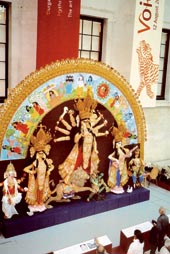 |
The British Museum, best known for its Egyptian mummies and Elgin Stones, has been the epicentre of a great Bengali upheaval for the past few weeks, with an exhibition called Voices of Bengal showcasing Bengali culture.
The impressive Great Court served as the venue for the creation of a spectacular 20-foot image of the goddess Durga. Fashioned on site by craftsmen from Kumartuli, clay from Devon and straw from English fields, Durga grew swiftly and by the third week of September, she stood resplendent in gold and daker saaj.
A group of dhakis from Murshidabad played in the Courtyard. Young tourists loved this image of the new Britain. Hundreds of schoolchildren listened to the Durga stories and gasped at the slaying of Mahishasura.
The installation was surrounded by live music and dance performances. I showcased British Bengali dancers in the piece Sakhi. It was a big journey for the young artistes from small community halls to the Great Court.
Voices of Bengal, August 12 to January 7, launched an exhibiton of Tagore’s paintings, part of the museum holdings but never displayed before. Thousands from the community turned up to witness Mahalaya celebrated in the Court.
Scores of sari-clad Bangladeshi women from East End, who probably stepped into the British Museum for the first time, did so to see the glorious Durga installation. This really had nothing to do with religion, rather everything with the cultural practice of both Bengals.
An exhibition featuring religious stories, scrolls and artefacts investigated the rich traditions of story-telling. The story new to me was from the 13-metre Gazi scroll that recounts the deeds of the saint who brought Islam to Bengal.
In that space Gurupada Chitrakar unfolded his patas (scrolls) and sang songs to a fascinated audience.
Then Durga had to be transferred to Camden Town Hall for worship. So we all walked in a procession, the curators of the Museum fell in, dhakis drummed, young people danced and cheered as Durga was taken on a truck with her children.
As the peak traffic was held back to let the procession pass through Bloomsbury, the traffic police quickly clicked their cameras and people opened doors and windows and cheered and clapped.
Young Sona Dutta of the British Museum shouted: “Did we ever dream that we would walk in such a procession and stop traffic in Bloomsbury?”
As cries of Durga Ma ki Jai rent the tranquil evening air around Russell Square, it seemed this assertion of cultural identity should finally boost the Bengali’s self confidence, somewhat lacking among the diaspora here.
That evening though, the Bengalis were as robust as the Punjabis and rocked to the music. And Durga was more beautiful than I ever remembered her — she reminded me of the traditional Maddox Square protima.
It’s been over five decades since a handful of Bengalis put together some money for Saraswati Puja. When one of the young men proposed Durga Puja, the others thought he was out of his mind.
But in 1962 the first Bengali Durga Puja took place in London, after £350 were raised by phoning every Bengali family in the London directory. The festival moved to Belsize Park. In 1991 it moved to Camden Town Hall. Today the five-day festival has 1,500 people go through its doors daily. As many people are fed twice a day.
Media attention brought in a new crowd this time. They were far more mainstream, tourists and Londoners. It was about connecting with new people.
An Irishman who loved his khichuri came back to take photographs every day (I suspect it was also the love of hot Indian food).
A lovely Scottish couple came every evening and said they had found new energy after knowing about the goddess — at once the fierce one and the protector.
Calcutta TV channels had swiftly sent in reporters and young beauties in their finery were being interviewed.
At last came the day when Durga had to leave. Another carefully planned operation to dismantle the huge framework, put the images in containers and transport them to the Thames under Putney Bridge. The day was sprinkled with showers and sunshine.
As we waited for high tide, the drummers hit it again and the dancers swayed gracefully with the music. Overhead, the bridge was full of people, even the red buses had stopped to see what was happening.
As Ma Durga was lifted, the rains came down, and curator Richard Blurton sighed: “There goes my Durga!” Almost as if to make him feel better, the sun splashed light on the bridge.
As Durga was immersed mid-stream, a huge rainbow magically arched on the skies. Durga floated swiftly downstream, clay to clay, and life was a circle once again.
l the stories and rhythms of the past few days concentrated into little drops of light. As a second rainbow sprang across the skies, I was left with a magical moment to clutch on to, as were the other teary-eyed Bengalis on the banks of the Thames.
Sangeeta Datta, an associate director of the under-production film Brick Lane, teaches at London University.

